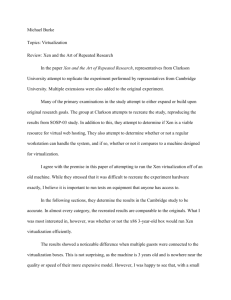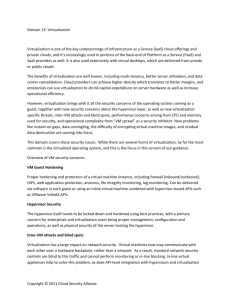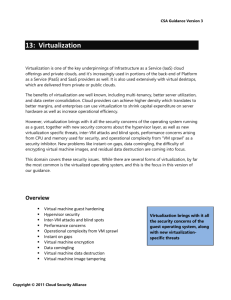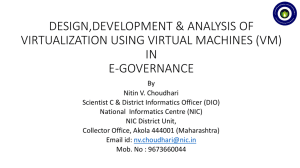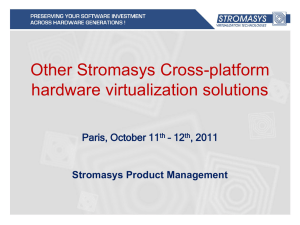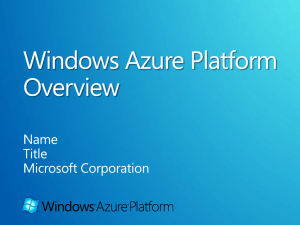xShare: Supporting Impromptu Sharing of Mobile Phones
advertisement
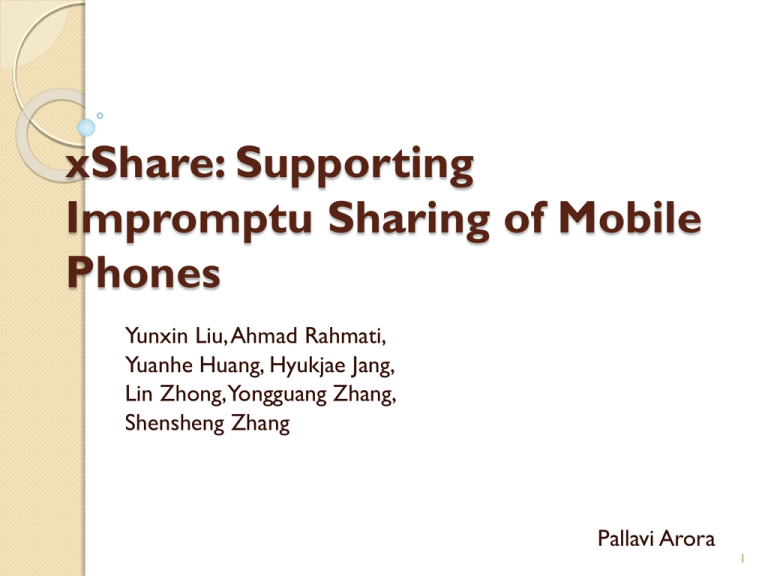
xShare: Supporting Impromptu Sharing of Mobile Phones Yunxin Liu, Ahmad Rahmati, Yuanhe Huang, Hyukjae Jang, Lin Zhong, Yongguang Zhang, Shensheng Zhang Pallavi Arora 1 Outline Motivation Previous works Understanding Phone Sharing Designing Challenges Implementation Evaluation 2 Motivation It is often necessary or desirable to share our phones. Reasons ◦ ◦ ◦ ◦ Lend for calling, texting Share music, photos, games etc. Show cool apps. Access to information for under-privleged. 3 Motivation Concerns ◦ Private Data ◦ excessive exhaustible or billable resources, such as battery and cellular minutes. Dealing with concerns ◦ Refrain from sharing ◦ Keep the phone in sight ◦ Prepare your phone by deleting, moving private data. 4 Motivation Current prevention ◦ password or PIN code for accessing the entire phone (all or none). ◦ VMware have recently announced upcoming VM solutions for mobile platforms. ◦ Windows CE Kiosk Mode. http://msdn.microsoft.com/en-us/library/aa446914.aspx Drawbacks ◦ mobile devices are processor and energy constrained ◦ additional overhead of VM solutions 5 Previous Work media sharing : desirable but not well supported by the existing technologies. Intel’s Ubiquity project: lightweight computer with high-density data storage capability, web server to push content to the connected device through a web browser. 6 Windows CE kiosk mode Use in specialized devices ◦ Restrict all the application barring a few. ◦ Disable games and other entertainment programs ◦ ATM, a point of service Existing Windows CE ◦ Windows Shell Start button, Taskbar ◦ Thin Client Shell directly into WBT/RDP shell ◦ Command Shell boots into command processor 7 Windows CE kiosk mode Requirements ◦ customized Windows CE image ◦ lengthy reboot No protection of data 8 Previous Work Enabling Context aware and PrivacyConscious User Data Sharing. Houdini framework ◦ context-aware and privacy-conscious user data sharing. Privacy-Conscious Personalization ◦ ◦ ◦ ◦ the requestee static data the requestee dynamic data the requester context the requestee preferences 9 Examples Enhanced Find Friends ◦ iLocator ◦ infer a user’s context using a combination of static and dynamic data ◦ serious privacy concerns Presence and Selective Reach-Me ◦ Provide requesters information about presence across all the devices associated with the person, ◦ suggest the best device(s) for communicating ◦ share this information only with authorized requesters 10 Building rule set user sets relevant parameters user sets preferences that are transformed into rules and data that can be interpreted by the rules engine system automatically learns preferences that are transformed into rules and data that can be interpreted by the rules engine. 11 Rules 12 Understanding Phone Sharing Interviews in four countries ◦ Nature of Sharing What applications With Whom Where Why Who is the initiator ◦ Privacy Concerns Classified user data Existing Protection Inadequate How owners deal with concerns 13 Understanding Phone Sharing 60 participants from China, Iran, Korea and USA 14 Understanding Phone Sharing 15 Understanding Phone Sharing Four month field trial ◦ Windows Mobile phone in Pecan Park, a lowincome urban community in Houston ◦ Fourteen teenagers ◦ Active sharing initially ◦ Impromptu ◦ Application driven and data-driven 16 Threat Model Impromptu policy creation Access control ◦ individual applications, data files and folders, and system resources Resource accounting ◦ exhaustible system resources and pay-by-use services Borrower data reconciliation ◦ accept or reject 17 Design Normal and Shared mode UI for owner to specify sharing policy Create virtual environment enforcing policies. Authentication to go back to normal mode. Accept or reject changes of shared mode. 18 Design 19 File based access control Application-independent solution. Symbian, Linux, Windows Mobile, iPhone OS, Blackberry, and Palm use files as abstraction for both data and applications. Unix-style mobile OS provide some access control for the file system. Rebuilding the ROM image not required. 20 Design Considerations Automatically selects applications for the selected files. Initially not shared profiles to enable frequently used sharing policies Quick Share ◦ Share only the open file or application. Prompt for changes in shared mode ◦ Default for modify is reject and new is accept. 21 Challenges In-Memory Services and Applications ◦ terminates corresponding processes before entering Shared Mode ◦ Some applications cannot be terminated properly Identifying Files for Application Sharing ◦ configuration files and DLLs ◦ allows access to all the files in the same folder as the corresponding executable 22 Virtual Environment Namespace Virtualization ◦ renaming resources Change Separation ◦ changes cannot affect the system in Normal Mode Hiding Non-shared Files ◦ namespace virtualization hides non-shared resources from shared applications 23 Implementation for Windows Mobile Intercept system APIs at the kernel-level. ◦ Implicit System APIs ◦ Handle-Based System APIs Load Interception DLL ◦ setting the callback function to LoadLibrary() and its parameter as the name of a DLL Access Control Implementation 24 Implicit and Handle based System APIs Globally registered and dispatched through the system API table. 25 Namespace Virtualization File System Virtualization ◦ track changes, maintain correct states, ensure a consistent appearance ◦ intercept 18 file-system APIs ◦ virtual link technique Change Separation through Path Mapping ◦ prefix changes with “\xShare\Root” ◦ virtual link file mapping physical path to intermediate path ◦ virtual recycle bin 26 Namespace Virtualization Hiding Non-shared Files ◦ interception routine CreateFile() returns ERROR_FILE_NOT_FOUND ◦ intercept FindFirstFile() and FindNextFile() Registry Virtualization ◦ virtualizes registry access to track the changes and separate them from Normal Mode ◦ Intercept 10 APIs 27 Virtualization C:\Users\MyData\data.txt \xShare\Root\C:\Users\MyData\data.txt C:\xShare\Root\Users\MyData\data.txt.vlin k 28 Tightly coupled services Ex. Messaging ◦ These services cannot be stopped ◦ Backup the data read by these services ◦ Delete the original file When the service/application is used in shared mode, data is not visible! Restore the backed up file when returning to normal mode Evaluation: Overhead No overhead when running in normal mode xShare interception layer requires 90KB of memory CreateFile() takes relatively more time; but absolute time is still negligible Evaluation: Latency Switching to shared mode takes about 5.8 seconds Switching back to normal mode takes about 3 seconds Evaluation: Energy consumption File I/O operations consume more energy in shared mode Audio/Video playback do not show any measurable differences. ◦ Because reading files does not have any overhead Evaluation 33 34 Video 35 Conclusions Light weight protection against unauthorized access by borrowers Not intended to protect data against theft Interesting statistics to show that users actually care about privacy API Interception and Virtualization used to sandbox applications and data

